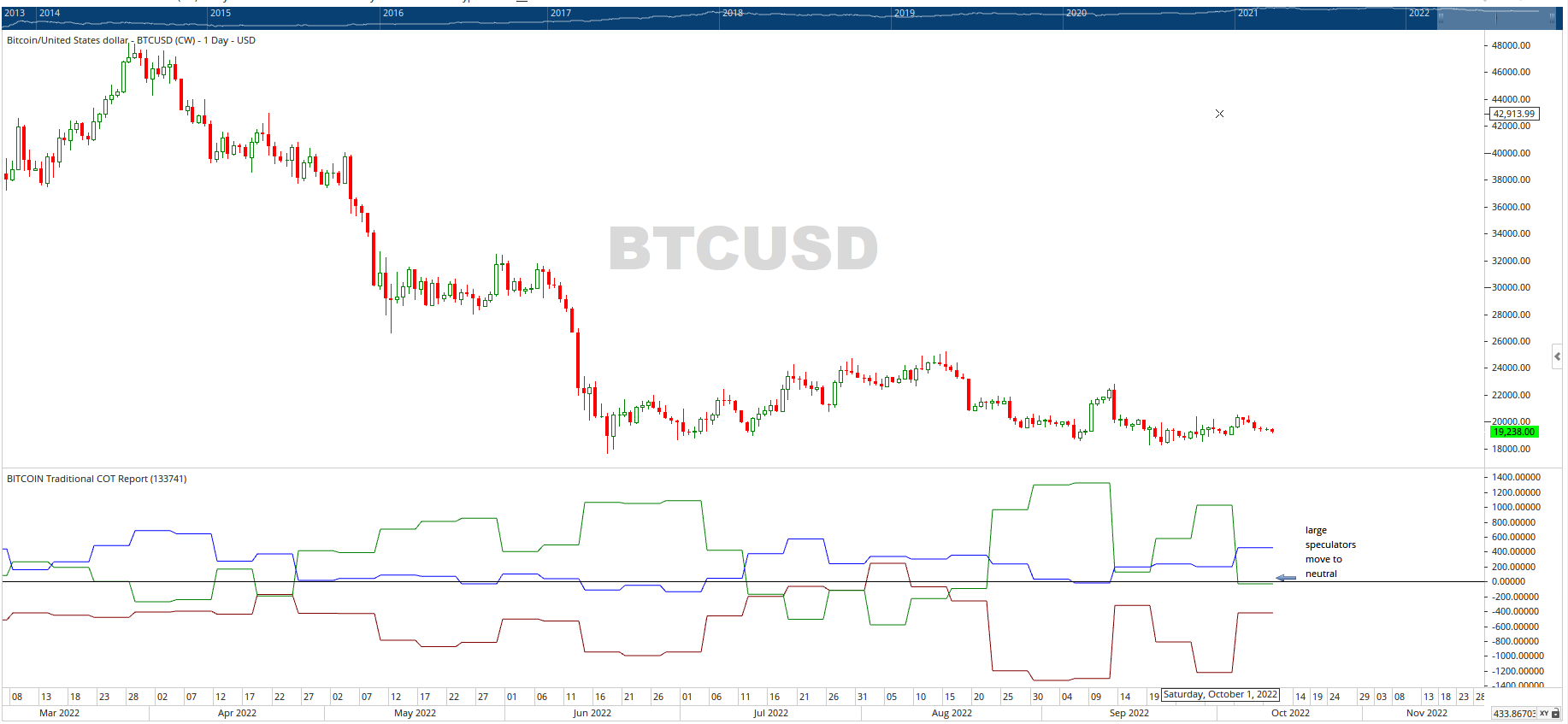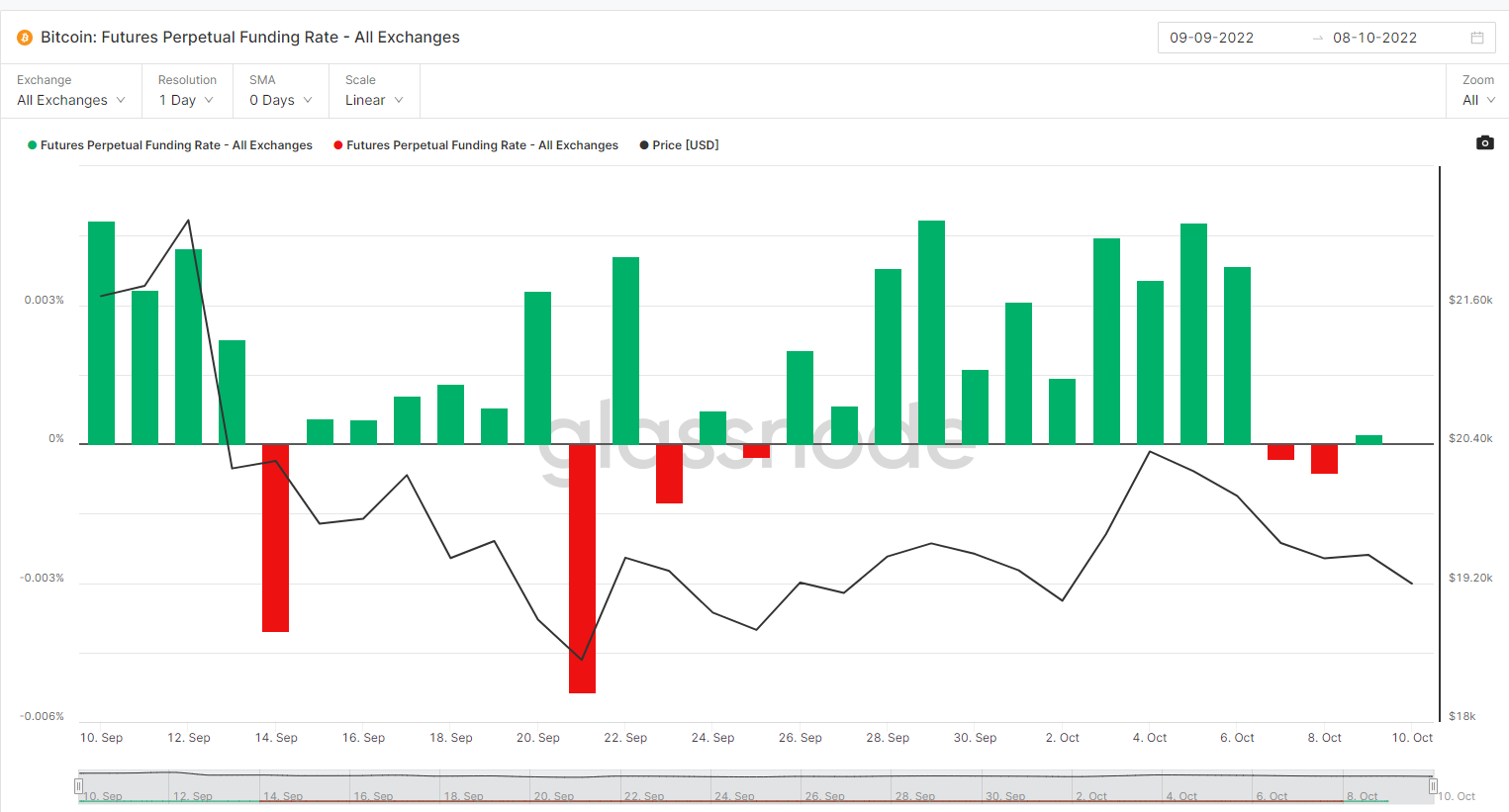Price Action
Bitcoin and ether started the work week slightly lower as markets await U.S. inflation data due Thursday.
Impactful economic data announcements will be light until that point, although investors will be scrutinizing September’s Federal Open Market Committee minutes, which the U.S. central bank will release Wednesday. The minutes will shape expectations for FOMC’s aggressiveness at its next meeting. FOMC is widely expected to raise the interest rate a hefty 75 basis points for a fourth consecutive time.
Bitcoin (BTC) recently declined 1.07% on below-average volume, falling 0.55% at the onset of U.S. trading hours. BTC’s daily volume has been below average in nine of the last 10 trading days, when compared to its 20-day moving average. The lack of volume suggests a lack of conviction, either bullish or bearish.
Ether (ETH) followed a similar path, declining 1.12%, also on below-average volume. ETH’s trading volume has fallen below its 20-day moving average for 12 consecutive days. The second-largest cryptocurrency by market capitalization now sits just above $1,300 and is down 65% year to date.
The CoinDesk Market Index (CMI), a broad-based market index that measures the performance of a basket of cryptocurrencies, is relatively flat, down 0.90%. The top mover on Monday was quantstamp (QSP), up 32.18% to $0.019, while the day’s laggard was injective protocol (INJ), down 7.18% to $1.81.
Macro View
Traditional financial markets were lower across the board, with the Dow Jones Industrial Average (DJIA), tech-heavy Nasdaq Composite and S&P 500 down 0.32%, 1.04% and 0.75%, respectively.
The Dollar index (DXY), which has held a largely inverse pricing relationship to BTC since August, is up 0.34%. BTC investors will be watching the index for signs of growing dollar strength, particularly in light of FOMC’s focus in reducing inflation.
In commodities, energy markets were lower, with WTI and European Brent crude down 2% and 2.1%, respectively. In metals, traditional safe-haven asset gold declined 2%, while copper futures rose 1.6%.
Latest Prices
● Bitcoin (BTC): $19,238 −1.2%
● Ether (ETH): $1,308 −1.0%
● CoinDesk Market Index (CMI): 952.64 −1.1%
● S&P 500 daily close: 3,612.39 −0.7%
● Gold: $1,675 per troy ounce −1.5%
● Ten-year Treasury yield daily close: 3.89% +0.005
Bitcoin, ether and gold prices are taken at approximately 4pm New York time. Bitcoin is the CoinDesk Bitcoin Price Index (XBX); Ether is the CoinDesk Ether Price Index (ETX); Gold is the COMEX spot price. Information about CoinDesk Indices can be found at coindesk.com/indices.
Technical Take
Bitcoin Continues Quiet Run Between $19,000 and $20,000

Bitcoin/U.S. dollar (Optuma)
BTC continues to trade flat, reflecting the absence of catalysts that would spur significant price movement in either direction. Investors currently appear content to sit idly just three days ahead of Thursday’s Consumer Price Index (CPI) data release.
The most recent Commitment of Traders report, released each Tuesday, showed that “large speculators” reduced their BTC holdings to essentially net neutral last week.
The COT report, published by the Commodity Futures Trading Corporation, displays the holdings of participants in U.S. futures markets for different assets.
The CFTC will release the latest report this Tuesday. With BTC up just 2% last week on below-average volume, it’s difficult to envision a scenario where large institutions purchased BTC en masse during the prior week.
The challenge for BTC and crypto assets in general appears related more to the overall economic environment than in market confidence in the asset itself.
BTC continues to be resilient in the face of challenging economic news, trading at an identical level to where it was in mid-June. Over that same time frame, the FOMC has raised interest rates three times and by 225 basis points, and is widely expected to raise rates by another 75 basis points in November.
The yield curve for two- and 10-year Treasurys continues to be inverted, and has been that way since July. Inverted yield curves have preceded recessions in 2008, 2001 and 1990, so investors have naturally been reluctant to allocate more capital to riskier assets, including crypto.
In a CNBC interview Monday morning, legendary hedge fund manager Paul Tudor Jones tempered his previous bitcoin bullishness, saying he had a “minor allocation” of the crypto.
Technical indicators continue to blink neutral as the daily 14-day Relative Strength Index for BTC is 44. An RSI of 70 indicates that an asset may be overvalued, and 30 implies that it may be undervalued. An RSI of 44 indicates neither. BTC is also trading just shy of its 20-day moving average of $19,383.
On-chain data appears to echo the neutral-for-now sentiment as well. A look at BTC funding rates shows that following 11 consecutive days of positive readings, BTC funding rates now sit at roughly zero.
Funding rates can serve as a proxy for market sentiment, with positive funding rates implying that markets are long biased and negative rates implying the opposite.

Bitcoin futures perpetual funding rate (Glassnode)
Altcoin Roundup
-
Crypto Investment Firm Blockwater Technologies Defaults on DeFi Loan: The South Korea-based crypto investment firm failed to make a payment on a $3.4 million loan in Binance USD (BUSD) stablecoin to TrueFi, a decentralized lending protocol. Read more here.
-
Back to Square One? Circle’s USDC Market Cap Drops Below $50B for First Time Since Terra’s Collapse: Circle’s dollar-pegged stablecoin USD coin (USDC)’s utility has taken a hit following Binance’s decision to consolidate order books and Circle’s decision to freeze addresses associated with Tornado Cash. Read more here.
Trending posts
-
Listen 🎧:Today’s “CoinDesk Markets Daily” podcast discusses the latest market movements and a look at a look at a potential future of central bank digital currencies (CBDC).
-
Crypto and Payments Firm MobileCoin Launches Stablecoin – ‘Electronic Dollars’:The company says eUSD will be “the first data-protecting stablecoin.”
-
Bitcoin Mining Difficulty Surges to All-Time High, Putting Additional Squeeze on Miners:The difficulty gauge rose 13.55% from the last adjustment roughly two weeks ago, the largest such move since May 2021.
-
Ethereum Scaling Tool Polygon Launches its zkEVM Public Testnet:The company continues to be targeting the mainnet going live sometime in early 2023.
-
Crypto Funds Witness Minor Outflows – but It’s Bullish, Actually: The majority of outflows were from “short” investment products, or those betting on price declines, according to CoinShares. It might be a sign that bearish sentiment is dissipating.
-
Transit Finance Hacker Returns $2.74M to Victims, Sends $686K to Tornado Cash:The hacker has sent $686,000 worth of BNB tokens to the sanctioned Tornado Cash protocol.
-
Lawmakers Overwhelmingly Back EU’s MiCA Crypto Law in Committee Vote:The landslide support paves the way for the landmark crypto licensing regulation to take effect in 2024.
-
The Organization for Economic Co-operation and Development Releases New Global Tax Reporting Framework for Crypto Assets:The OECD framework’s scope will include stablecoins, crypto derivatives and certain non-fungible tokens (NFT).
CoinDesk Market Index
Biggest Gainers
| Asset | Ticker | Returns | DACS Sector |
|---|---|---|---|
| Celsius | CEL | +8.89% | Currency |
| Injective | INJ | +8.33% | DeFi |
| 1inch Network | 1INCH | +6.79% | DeFi |
Biggest Losers
| Asset | Ticker | Returns | DACS Sector |
|---|---|---|---|
| Numeraire | NMR | -6.56% | DeFi |
| Immutable X | IMX | -3.79% | Culture & Entertainment |
| EOS | EOS | -3.76% | Smart Contract Platform |
Sector classifications are provided via the Digital Asset Classification Standard (DACS), developed by CoinDesk Indices to provide a reliable, comprehensive and standardized classification system for digital assets. The CoinDesk Market Index (CMI) is a broad-based index designed to measure the market capitalization weighted performance of the digital asset market subject to minimum trading and exchange eligibility requirements.





